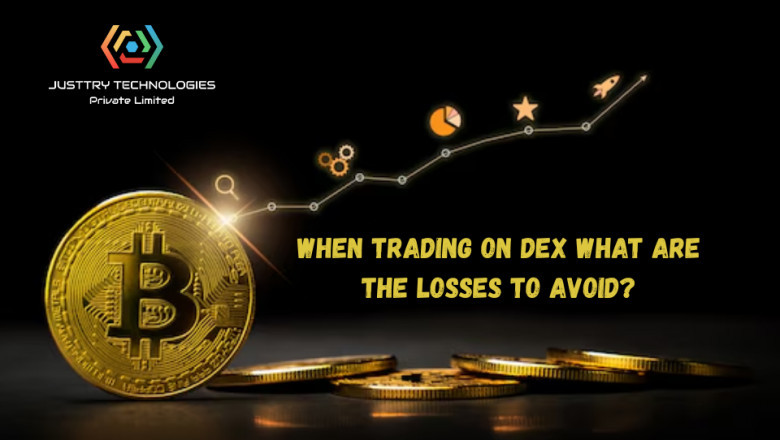views
Introduction
Decentralized exchanges (DEXs) are transforming the way crypto traders operate, offering greater security, transparency, and control over assets. However, they also come with unique risks that can lead to financial losses if not carefully managed. From impermanent loss to high slippage, understanding these potential pitfalls is crucial for traders looking to maximize profits.
This guide explores the common losses traders face on Decentralized crypto exchanges (DEXs) and how to avoid them. Whether you're an experienced investor or just getting started, these insights will help you navigate the decentralized trading landscape with confidence.
1. Impermanent Loss – The Silent Profit Killer
Liquidity providers (LPs) often experience impermanent loss when the value of their deposited assets fluctuates compared to simply holding them in a wallet.
-
Occurs in Automated Market Makers (AMMs): DEXs like Uniswap and PancakeSwap use AMM models, where LPs deposit token pairs to provide liquidity.
-
Caused by Price Volatility: When the price of one asset in the pair changes significantly, it creates an imbalance in the pool, leading to potential losses.
-
Mitigation Strategies: Opt for pools with stable pairs, use impermanent loss protection services, and diversify liquidity investments.
2. Slippage – The Hidden Cost of Trading
Slippage occurs when the executed trade price differs from the expected price due to liquidity constraints.
-
Common in Low Liquidity Pools: Thin order books can lead to higher price discrepancies, making it harder to execute large trades.
-
Impact on Traders: Small trades may experience minor slippage, but larger orders can lead to significant losses.
-
How to Avoid It: Use limit orders instead of market orders, trade in highly liquid pools, and adjust slippage tolerance settings wisely.
3. High Gas Fees – The Cost of Decentralization
Transaction fees on blockchain networks can fluctuate dramatically, affecting profitability.
-
Ethereum Network Congestion: High gas fees are common on Ethereum-based DEXs, especially during peak trading hours.
-
Alternative Chains: Binance Smart Chain (BSC), Polygon, and Solana offer lower transaction fees, making them more cost-effective.
-
Fee Optimization: Use layer-2 scaling solutions like Optimism and Arbitrum to reduce gas costs.
4. Smart Contract Risks – The Security Threat
DEXs rely on smart contracts, which can have vulnerabilities that hackers exploit.
-
Code Exploits: Even well-audited smart contracts can have bugs leading to fund losses.
-
Rug Pulls & Exit Scams: Some projects abandon liquidity pools, leaving investors with worthless tokens.
-
How to Stay Safe: Only trade on reputable DEXs, review contract audits, and avoid newly launched, unverified tokens.
5. Front-Running & MEV Attacks
Miner Extractable Value (MEV) attacks occur when bots detect pending transactions and manipulate the order to profit.
-
How It Works: Bots place a trade before a detected large order, forcing traders to buy at a higher price.
-
Common on Public Blockchains: Since transaction data is visible, bots can exploit trading behaviors.
-
Preventative Measures: Use private transactions on platforms like Flashbots and spread out trade sizes to avoid detection.
6. Fake Tokens & Phishing Scams
The decentralized nature of DEXs allows anyone to create and list tokens, which scammers exploit.
-
Duplicate Token Listings: Fraudsters create fake versions of legitimate tokens to deceive traders.
-
Phishing Attacks: Fake DEX websites and malicious links can steal private keys or seed phrases.
-
How to Stay Protected: Verify token contracts on official websites and avoid clicking on unknown links.
7. Liquidity Drain Risks
Low liquidity pools can lead to price manipulation and high price impact when executing trades.
-
Slippage Spikes: A low-volume token may experience extreme price swings with even a small trade.
-
Liquidity Rug Pulls: If liquidity providers withdraw large amounts, the remaining pool becomes unstable.
-
Safe Trading Practices: Always check liquidity depth before trading and avoid newly created pools with low volume.
Conclusion
Trading on DEXs offers immense benefits, but the risks cannot be ignored. By understanding and avoiding common losses like impermanent loss, slippage, smart contract vulnerabilities, and liquidity risks, traders can make more informed decisions.
Working with a top crypto exchange development company can help ensure secure trading experiences, whether you're developing a new crypto exchange platform or using existing ones. Platforms offering crypto exchange software solutions and cryptocurrency exchange development services can help enhance security, efficiency, and profitability in the DeFi space.
Stay informed, trade wisely, and minimize your risks in the ever-evolving world of decentralized exchanges.














Comments
0 comment